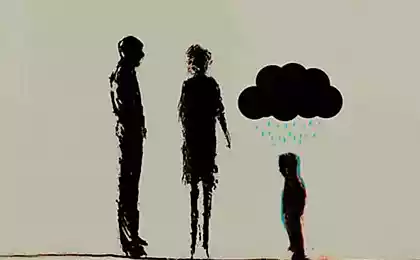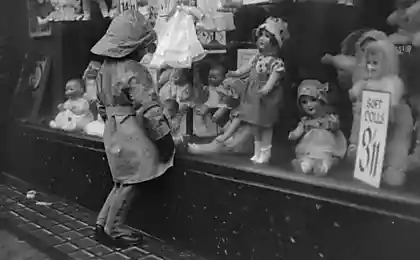588
Aggressive child: the impact of television!
In the early 60-ies of the psychologist albert bandura decided to find out whether children tend to imitate aggressive behavior of adults. He took a huge inflatable clown doll, called Bobo, and directed the film as an adult aunt scolds him, thrashes, kicks and even hits it with a hammer. Then he showed this video group of 24 preschoolers. The second group showed a video without violence, and the third nothing at all showed.
Then all three groups alternately launched into the room where was Bobo the clown, a few hammers and even toy guns, although no one video no firearm appeared.
Children who watched the aggressive video wasted no time began to torment the poor Bobo. One boy put the head of a clown gun and began to whisper something about how happy to blow his brains out. In the other two groups there was not even a hint of violence.
After bandura presented their findings to the scientific community, there were many skeptics who said that all this proves nothing, as the rubber doll and to come up to her to kick.

Then bandura made a film with the abuse of living a grown man dressed as a clown, then gathered more children, he showed them his imperishable and again launched into the room to the (now live!) Bobo. As many of you may have guessed, and without any experiment, the children began to insult, kick and beat the living clown, with the same zeal as the first time.
This time the statement of Bandura that children imitate the behavior of adults, no one can dispute is not resolved.
In the whole industrial world, 98 % of households have a TV. Those who have baths and phones, much less. TV creates a global pop culture. The average family TV set works up to 7 hours a day for each family member on average for 4 hours. What types of social behavior modeled in this watch?
John. Gerbner his other colleagues for 30 years daily through the broadcasting network Prime time and Saturday morning programs. What did they find? Two out of three programs contain scenes of violence (“actions physical compulsions, accompanied by threats of beating or killing or beating or killing as such”).
By the end of the middle school child is viewing on television about 8,000 scenes with murders and 100,000 other acts involving violence. This applies only to television, excluding other sources.
Thinking about his calculations, held them for 22 years, Gerbner concludes: “In the history of mankind there have been more bloodthirsty eras but none of them were to such an extent saturated with images of violence as ours.
And who knows where we will carry out this monstrous thread visible violence seeping into every home via flickering TV screens in the form of perfectly-orchestrated scenes of violence. Defenders of the idea that the viewer (not clear)... shall be exempt from the aggressive energy and thus the TV to prevent aggression, one may argue that “Television was not involved in the mass extermination of Jews and native Americans. TV only reflects our tastes and cater to them.” Critics of this theory argue: “But it is also true that in the age of television in America (for example) the number of crimes involving violence, began to increase several times faster than the population. Unlikely pop culture only passively reflects the tastes, without affecting the public consciousness”.
Imitate whether the audience of the display patterns of violence?
Examples of the playback of the crimes shown on television. In a survey of 208 prisoners, 9 out of every 10 admitted: television programs about crime may learn new criminal tricks. Every 4 out of 10 said tried to commit some crimes, seen once on the TV screen.
To have the scientific evidence to examine the impact of television on crime, the researchers used correlational and experimental methods in parallel. Can we conclude that the bloody Teledata gives plentiful food for aggression? Maybe aggressive children prefer to watch aggressive programs? Or is there some other factor – say, low intelligence predisposes some children to prefer aggressive programmes, and to commit aggressive acts?
According to research, viewing the militants in 8 years in a moderate way determines the aggressiveness at age 19, but aggressiveness at age 8 did not prejudge the passion militants in 19 years.
This means that aggressive tendencies make people fans of “cool” films, but rather “cool” movies are able to provoke a person to commit violence.
These results were confirmed in recent research conducted on 758 adolescents in Chicago and 220 adolescents in Finland. Moreover, when iron and Hulsmann (American psychologists) referred to the minutes of the first studies with eight-year-olds, and found there information about those convicted of a crime, found the following: 30-year-old man, who in childhood I watched a lot of “cool” TV shows, are more likely to have committed serious crimes. But that's not all.
Everywhere and always with the advent of television increased the number of murders. In Canada and the U.S. between 1957 and 1974, with the spread of television murder was committed twice. In those covered by the census regions, where television came later, the wave of killings has also risen late. Similarly, in well-studied rural areas of Canada, where television came later, soon observed a doubling of the level of aggressiveness on the sports courts. For the skeptics will notice that the results of correlational and experimental studies have been repeatedly verified and are chosen so that the presence of outsiders, of “third” factors is excluded. Laboratory experiments coupled with public concern was the impetus for the submission to the Commission in the Main medical Department of the United States materials 50 new studies. These studies have confirmed that witnessing violence increases aggression.
The influence of the media on children's aggression
Modern art changes and deforms the psyche of the child, by acting on the imagination, giving new attitudes and behaviors. From the virtual world in the minds of children burst into a false and dangerous values: couldry, aggression, rude and vulgar behavior, which leads to hyperexcitability children.
In Western cartoons is the fixation on aggression. The repetition of scenes of sadism, when the hero of the cartoon causes someone pain, causes children to commit aggression and promotes the development of appropriate behaviours.
Children repeat what they see on the screens is the result of identification. Identifying with the creature, deviant behavior, which it did on the screen is not punished and even condemned, the children imitate him and learn his aggressive behaviour. Albert bandura in 1970 said that one television model can be imitated for millions.
Killing, in computer games, children feel a sense of satisfaction, mentally violating moral norms. Virtual reality is no scale of human feelings, by killing and suppressing the child is not experiencing normal human emotions: pain, sympathy, empathy. On the contrary, the habitual feelings are distorted here, instead the child gets pleasure from hitting and insults and private permissiveness.
Aggression in cartoons is accompanied by beautiful, vivid pictures. Heroes are beautifully dressed, or are in a beautiful room or just showing off a beautiful scene, which is accompanied by murder, fighting and other aggressive behaviors this is to ensure that the cartoon was drawn. Because if on the basis of existing notions of beauty to pour images of sadism, thus blurring the already established representation. Thus, a aesthetic perception, a new culture of man. And these cartoons and movies kids want to watch, and they are already perceived as the norm. Children are drawn to them, and don't understand why adults with traditional notions of beauty, on the norm don't want to show them.
Often the characters of Western cartoons ugly and looks disgusting. What does it do? The fact that the child identificeret not only with the behavior of the character. Mechanisms of imitation in children reflex and so thin that they allow to catch the slightest emotional changes, tiny facial grimaces. Monsters are evil, stupid, crazy. And identificeret the characters, children correlate their feelings with the expression on their faces, And begin to appropriate: it is impossible to adopt the evil facial expressions and stay in the good-natured soul, to adopt a meaningless grin and strive to "gnaw granite of science", as in "sesame Street"
The atmosphere of the market is riddled with murderers, rapists, witches, and other characters with whom communication would never choose in real life. And children can see it on the TV screen. In children, the subconscious is not yet protected by common sense and life experience that allow to distinguish real and nominal. The child is seen as the reality imprinted for life. TV screen c violence of the adult world have replaced grandmothers and mothers, reading, introduction to authentic culture. Hence the growth of emotional and mental disorders, depression, teenage suicides, unwarranted violence in children.
The main danger of TV is connected with suppression of will and consciousness, similar to what is achieved with drugs. American psychologist A. Mori writes that prolonged contemplation of the material, tiring vision, produces a hypnotic numbness that is accompanied by a weakening of will and attention. At a certain exposure duration of the light flash, flicker and a certain rhythm begin to interact with brain alpha rhythms, which depend on the ability of concentration, and disorder of brain rhythmic and develops the syndrome of attention disorders with hyperactivity.
The flow of visual and auditory information, requiring concentration and mental effort, perceived passively. It is eventually transferred to real life, and the child begins to perceive it as well. And already focus on the task, make a mental or volitional effort harder. The child becomes accustomed to only do what doesn't require effort. Child labor is included in the classroom, fully aware of the educational information. And without an active mental activity is not the development of neural connections, memory, associations.
Computer and TV robs children of their childhood. Instead of active games, experiences real emotions and feelings and communicate with peers and parents, the knowledge of itself through the surrounding living world, children spend hours, and sometimes days and nights sit at the TV and the computer depriving themselves of the development opportunities that is given to man only in childhood. published
P. S. And remember, only by changing their consumption — together we change the world! ©
Join us in Facebook , Vkontakte, Odnoklassniki
Source: whatisgood.ru/nasilie-na-tv/
Then all three groups alternately launched into the room where was Bobo the clown, a few hammers and even toy guns, although no one video no firearm appeared.
Children who watched the aggressive video wasted no time began to torment the poor Bobo. One boy put the head of a clown gun and began to whisper something about how happy to blow his brains out. In the other two groups there was not even a hint of violence.
After bandura presented their findings to the scientific community, there were many skeptics who said that all this proves nothing, as the rubber doll and to come up to her to kick.

Then bandura made a film with the abuse of living a grown man dressed as a clown, then gathered more children, he showed them his imperishable and again launched into the room to the (now live!) Bobo. As many of you may have guessed, and without any experiment, the children began to insult, kick and beat the living clown, with the same zeal as the first time.
This time the statement of Bandura that children imitate the behavior of adults, no one can dispute is not resolved.
In the whole industrial world, 98 % of households have a TV. Those who have baths and phones, much less. TV creates a global pop culture. The average family TV set works up to 7 hours a day for each family member on average for 4 hours. What types of social behavior modeled in this watch?
John. Gerbner his other colleagues for 30 years daily through the broadcasting network Prime time and Saturday morning programs. What did they find? Two out of three programs contain scenes of violence (“actions physical compulsions, accompanied by threats of beating or killing or beating or killing as such”).
By the end of the middle school child is viewing on television about 8,000 scenes with murders and 100,000 other acts involving violence. This applies only to television, excluding other sources.
Thinking about his calculations, held them for 22 years, Gerbner concludes: “In the history of mankind there have been more bloodthirsty eras but none of them were to such an extent saturated with images of violence as ours.
And who knows where we will carry out this monstrous thread visible violence seeping into every home via flickering TV screens in the form of perfectly-orchestrated scenes of violence. Defenders of the idea that the viewer (not clear)... shall be exempt from the aggressive energy and thus the TV to prevent aggression, one may argue that “Television was not involved in the mass extermination of Jews and native Americans. TV only reflects our tastes and cater to them.” Critics of this theory argue: “But it is also true that in the age of television in America (for example) the number of crimes involving violence, began to increase several times faster than the population. Unlikely pop culture only passively reflects the tastes, without affecting the public consciousness”.
Imitate whether the audience of the display patterns of violence?
Examples of the playback of the crimes shown on television. In a survey of 208 prisoners, 9 out of every 10 admitted: television programs about crime may learn new criminal tricks. Every 4 out of 10 said tried to commit some crimes, seen once on the TV screen.
To have the scientific evidence to examine the impact of television on crime, the researchers used correlational and experimental methods in parallel. Can we conclude that the bloody Teledata gives plentiful food for aggression? Maybe aggressive children prefer to watch aggressive programs? Or is there some other factor – say, low intelligence predisposes some children to prefer aggressive programmes, and to commit aggressive acts?
According to research, viewing the militants in 8 years in a moderate way determines the aggressiveness at age 19, but aggressiveness at age 8 did not prejudge the passion militants in 19 years.
This means that aggressive tendencies make people fans of “cool” films, but rather “cool” movies are able to provoke a person to commit violence.
These results were confirmed in recent research conducted on 758 adolescents in Chicago and 220 adolescents in Finland. Moreover, when iron and Hulsmann (American psychologists) referred to the minutes of the first studies with eight-year-olds, and found there information about those convicted of a crime, found the following: 30-year-old man, who in childhood I watched a lot of “cool” TV shows, are more likely to have committed serious crimes. But that's not all.
Everywhere and always with the advent of television increased the number of murders. In Canada and the U.S. between 1957 and 1974, with the spread of television murder was committed twice. In those covered by the census regions, where television came later, the wave of killings has also risen late. Similarly, in well-studied rural areas of Canada, where television came later, soon observed a doubling of the level of aggressiveness on the sports courts. For the skeptics will notice that the results of correlational and experimental studies have been repeatedly verified and are chosen so that the presence of outsiders, of “third” factors is excluded. Laboratory experiments coupled with public concern was the impetus for the submission to the Commission in the Main medical Department of the United States materials 50 new studies. These studies have confirmed that witnessing violence increases aggression.
The influence of the media on children's aggression
Modern art changes and deforms the psyche of the child, by acting on the imagination, giving new attitudes and behaviors. From the virtual world in the minds of children burst into a false and dangerous values: couldry, aggression, rude and vulgar behavior, which leads to hyperexcitability children.
In Western cartoons is the fixation on aggression. The repetition of scenes of sadism, when the hero of the cartoon causes someone pain, causes children to commit aggression and promotes the development of appropriate behaviours.
Children repeat what they see on the screens is the result of identification. Identifying with the creature, deviant behavior, which it did on the screen is not punished and even condemned, the children imitate him and learn his aggressive behaviour. Albert bandura in 1970 said that one television model can be imitated for millions.
Killing, in computer games, children feel a sense of satisfaction, mentally violating moral norms. Virtual reality is no scale of human feelings, by killing and suppressing the child is not experiencing normal human emotions: pain, sympathy, empathy. On the contrary, the habitual feelings are distorted here, instead the child gets pleasure from hitting and insults and private permissiveness.
Aggression in cartoons is accompanied by beautiful, vivid pictures. Heroes are beautifully dressed, or are in a beautiful room or just showing off a beautiful scene, which is accompanied by murder, fighting and other aggressive behaviors this is to ensure that the cartoon was drawn. Because if on the basis of existing notions of beauty to pour images of sadism, thus blurring the already established representation. Thus, a aesthetic perception, a new culture of man. And these cartoons and movies kids want to watch, and they are already perceived as the norm. Children are drawn to them, and don't understand why adults with traditional notions of beauty, on the norm don't want to show them.
Often the characters of Western cartoons ugly and looks disgusting. What does it do? The fact that the child identificeret not only with the behavior of the character. Mechanisms of imitation in children reflex and so thin that they allow to catch the slightest emotional changes, tiny facial grimaces. Monsters are evil, stupid, crazy. And identificeret the characters, children correlate their feelings with the expression on their faces, And begin to appropriate: it is impossible to adopt the evil facial expressions and stay in the good-natured soul, to adopt a meaningless grin and strive to "gnaw granite of science", as in "sesame Street"
The atmosphere of the market is riddled with murderers, rapists, witches, and other characters with whom communication would never choose in real life. And children can see it on the TV screen. In children, the subconscious is not yet protected by common sense and life experience that allow to distinguish real and nominal. The child is seen as the reality imprinted for life. TV screen c violence of the adult world have replaced grandmothers and mothers, reading, introduction to authentic culture. Hence the growth of emotional and mental disorders, depression, teenage suicides, unwarranted violence in children.
The main danger of TV is connected with suppression of will and consciousness, similar to what is achieved with drugs. American psychologist A. Mori writes that prolonged contemplation of the material, tiring vision, produces a hypnotic numbness that is accompanied by a weakening of will and attention. At a certain exposure duration of the light flash, flicker and a certain rhythm begin to interact with brain alpha rhythms, which depend on the ability of concentration, and disorder of brain rhythmic and develops the syndrome of attention disorders with hyperactivity.
The flow of visual and auditory information, requiring concentration and mental effort, perceived passively. It is eventually transferred to real life, and the child begins to perceive it as well. And already focus on the task, make a mental or volitional effort harder. The child becomes accustomed to only do what doesn't require effort. Child labor is included in the classroom, fully aware of the educational information. And without an active mental activity is not the development of neural connections, memory, associations.
Computer and TV robs children of their childhood. Instead of active games, experiences real emotions and feelings and communicate with peers and parents, the knowledge of itself through the surrounding living world, children spend hours, and sometimes days and nights sit at the TV and the computer depriving themselves of the development opportunities that is given to man only in childhood. published
P. S. And remember, only by changing their consumption — together we change the world! ©
Join us in Facebook , Vkontakte, Odnoklassniki
Source: whatisgood.ru/nasilie-na-tv/
15 life quotes from Stephen Hawking
A woman who has learned to respect herself cannot be manipulated.























